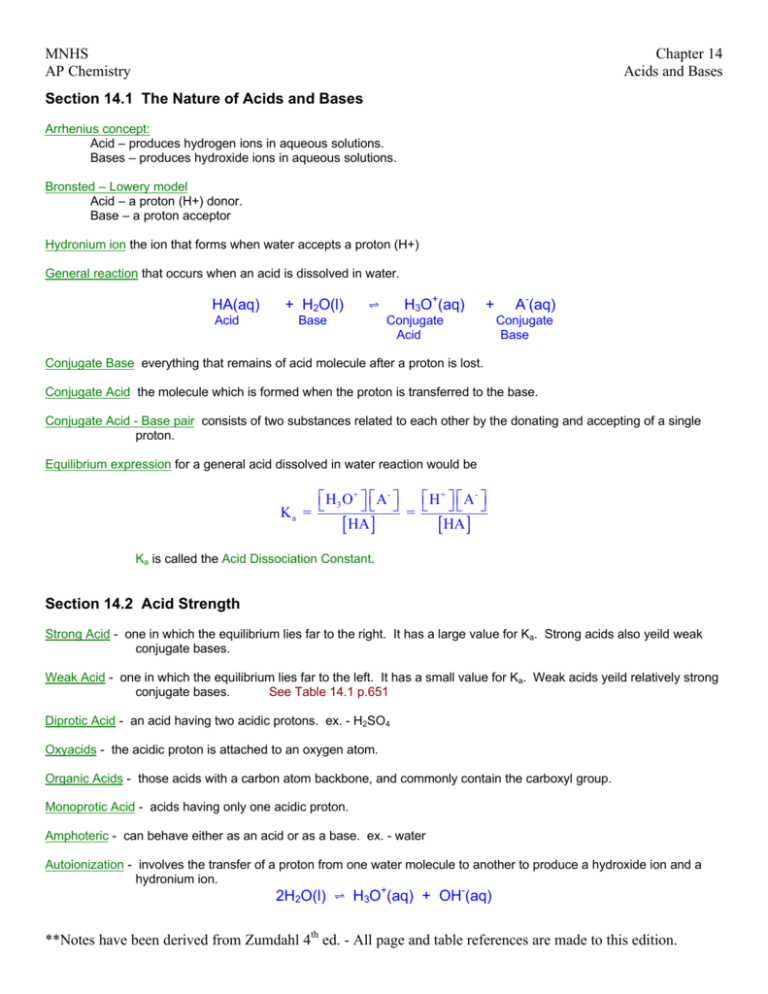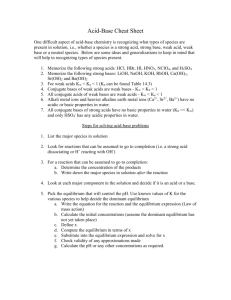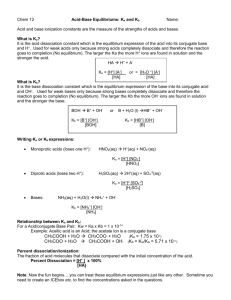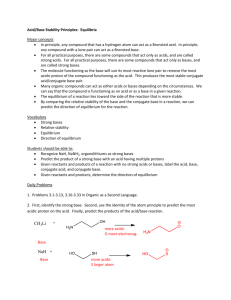Chapter 14 Notes
advertisement

MNHS AP Chemistry Chapter 14 Acids and Bases Section 14.1 The Nature of Acids and Bases Arrhenius concept: Acid – produces hydrogen ions in aqueous solutions. Bases – produces hydroxide ions in aqueous solutions. Bronsted – Lowery model Acid – a proton (H+) donor. Base – a proton acceptor Hydronium ion the ion that forms when water accepts a proton (H+) General reaction that occurs when an acid is dissolved in water. HA(aq) Acid + H2O(l) H3O+(aq) º Base + Conjugate Acid A-(aq) Conjugate Base Conjugate Base everything that remains of acid molecule after a proton is lost. Conjugate Acid the molecule which is formed when the proton is transferred to the base. Conjugate Acid - Base pair consists of two substances related to each other by the donating and accepting of a single proton. Equilibrium expression for a general acid dissolved in water reaction would be H3 O+ A- H + A - Ka = = [ HA ] [HA ] Ka is called the Acid Dissociation Constant. Section 14.2 Acid Strength Strong Acid - one in which the equilibrium lies far to the right. It has a large value for Ka. Strong acids also yeild weak conjugate bases. Weak Acid - one in which the equilibrium lies far to the left. It has a small value for Ka. Weak acids yeild relatively strong conjugate bases. See Table 14.1 p.651 Diprotic Acid - an acid having two acidic protons. ex. - H2SO4 Oxyacids - the acidic proton is attached to an oxygen atom. Organic Acids - those acids with a carbon atom backbone, and commonly contain the carboxyl group. Monoprotic Acid - acids having only one acidic proton. Amphoteric - can behave either as an acid or as a base. ex. - water Autoionization - involves the transfer of a proton from one water molecule to another to produce a hydroxide ion and a hydronium ion. 2H2O(l) º H3O+(aq) + OH-(aq) **Notes have been derived from Zumdahl 4th ed. - All page and table references are made to this edition. MNHS AP Chemistry Chapter 14 Acids and Bases Ion-Product Constant Kw (or dissociation constant for water) - always refers to the autoionization of water. Using the above reaction for the autoionization of water: Kw = [H3O+][OH-] = [H+][OH-] at 25°C [H+] = [OH-] = 1.0 × 10-7 so at 25°C Kw = (1.0 × 10-7 M)2 = 1.0 × 10-14 mol2/L2 It is important to recognize the meaning of Kw. The product of [H+] and [OH-] must always equal 1.0 × 10-14. This lends itself to three possibilities: 1. A neutral solution, where [H+] = [OH-]. 2. An acidic solution, where [H+] > [OH-]. 3. A basic solution, where [H+] < [OH-]. Section 14.3 The pH Scale pH Scale - provides a convenient way to represent solution acidity pH = -log [H+] Significant Figures for Logarithms - the number of decimal places in the log is equal to the number of significant figures in the original number. Similar scales can be formed for pK and pOH. pOH = -log [OH-] pK = -log K Many relationships maybe formed between these three equations - useful equations to know Kw = [H+][OH-] log Kw = log [H+] + log [OH-] pKw = pH + pOH and at 25°C pH + pOH = 14.00 Section 14.4 Calculating the pH of Strong Acid Solutions Common Strong Acids - (commit to memory) - HCl (aq), HNO3(aq), H2SO4(aq), and HclO4(aq) One key to solving acid-base equilibrium, is you must focus on the solution components and their chemistry. Major Species - are those solution components present in relatively large amounts. Section 14.5 Calculating the pH of Weak Acid Solution Step 1 - List the major species in the solution. Step 2 - Choose the species that can produce H+, and write a balanced equation for the reaction producing H+. Step 3 - Using the values of the equilibrium constant for the reactions you have written, decide which equilibrium will dominate in producing H+. Step 4 - Write the equilibrium expression for the dominant equilibrium. **Notes have been derived from Zumdahl 4th ed. - All page and table references are made to this edition. MNHS AP Chemistry Chapter 14 Acids and Bases Step 5 - List the initial concentrations of the species participating in the dominant equilibrium. Step 6 - Define the change needed to achieve equilibrium; that is, define x. Step 7 - Write the equilibrium concentrations in terms of x. Step 8 - Substitute the equilibrium concentrations into the equilibrium expression. Step 9 - Solve for x the "easy" way: that is by assuming [HA]0 - x ≈ [HA]0 Step 10 - Using the 5% rule verify whether the approximation is valid. Step 11 - Calculate [H+] and pH 5% Rule - x × 100 < 5 % then the approximation is acceptable. [ HA ]0 ( L) initial concentration ( mol ) L amount dissociated mol Percent Dissociation - Percent dissociation = × 100% For a given weak acid, the percent dissociation increases as the acid becomes more dilute. For solutions of any weak acid HA, [H+] decreases as [HA]0 decreases, but the percent dissociation increases as [HA]0 decreases. Section 14.6 Bases Strong Base - one which dissociates completely in water and has large Kb values. General reaction for a base B and water is given by: B(aq) Base + H2O(l) º Acid BH+(aq) Conjugate Acid + OH-(aq) Conjugate Base The equilibrium constant for this equation: BH + OH - Kb = [ B] Weak Base - small Kb values. Section 14.7 Polyprotic Acids Polyprotic Acids - acids which can furnish more than one proton. Table 14.4 p.677 - important Ka values. Characteristics of Weak Polyprotic Acids 1 Typically, successive Ka values are so much smaller than the first value that only the first dissociation step makes a significant contribution to the equilibrium concentration of H+. This means that the calculation of the pH for a solution of a typical weak polyprotic acid is identical to that for a solution of a weak monoprotic acid. 2 Sulfuric acid is unique in being a strong acid in its first dissociation step and a weak acid in its second step. For + relatively concentrated solutions of sulfuric acid (1.0 M or higher), the large concentration of H from the first dissociation step represses the second step. Which can be neglected as a contributor of H+ ions. For dilute solutions of sulfuric acid, the second step does make a significant contribution, and the quadratic equation must be used to obtain the total H+ concentration. **Notes have been derived from Zumdahl 4th ed. - All page and table references are made to this edition. MNHS AP Chemistry Chapter 14 Acids and Bases Section 14.8 Acid - Base Properties of Salts Salt - another name for an ionic compound. Salts that produce neutral solutions - salts that consist of the cations of strong bases and the anions of strong acids have no effect on [H+] when dissolved in water. Salts that produce basic solutions - any salt whose cation has neutral properties and whose anion is the conjugate base of a weak acid, the aqueous solution will be basic. Ex: C2H3O2 -(aq) + H2O(l) º Conjugate base of the weak acid HC2H3O2(aq) + OH -(aq) Weak acid Salts that produce acidic solutions - salts in which the anion is not a base and the cation is the conjugate acid of a weak base produce acidic solutions. Ex: NH4+(aq) º Conjugate acid of the weak base NH3(aq) + H+(aq) Weak base Highly charged metal ions - salts which contain highly charged metal ions produce an acidic solution. The metal ion becomes hydrated which then causes the solution to become acidic. See p. 687 - 689 (and Table 14.6) Section 14.9 The Effect of Structure on Acid-Base Properties There are two main factors that determine whether a molecule containing an X - H bond will behave as a Bronsted-Lowry acid: the strength of the bond and the polarity of the bond. Increased polarity and high electron density typically lends to large Ka values (strong acids). Section 14.10 Acid-Base Properties of Oxides A compound containing the H - O - X group will produce an acidic solution in water if the O - X bond is strong and covalent. If the O - X bond is ionic, the compound will produce a basic solution in water. Acidic Oxides - a covalent oxide dissolves in water, and an acidic solution forms. + Basic Oxides - an ionic oxide dissolves in water, and oxide has a great affinity for H causing basic solutions. Section 14.11 The Lewis Acid-Base Model Lewis acid - is an electron-pair acceptor. Lewis base - is an electron-pair donor. The Lewis model encompasses the Bronsted-Lowry model, but the reverse is not true. Section 14.12 Strategy for Solving Acid-Base Problems: A Summary Read through pages 695 - 696 **Notes have been derived from Zumdahl 4th ed. - All page and table references are made to this edition.






